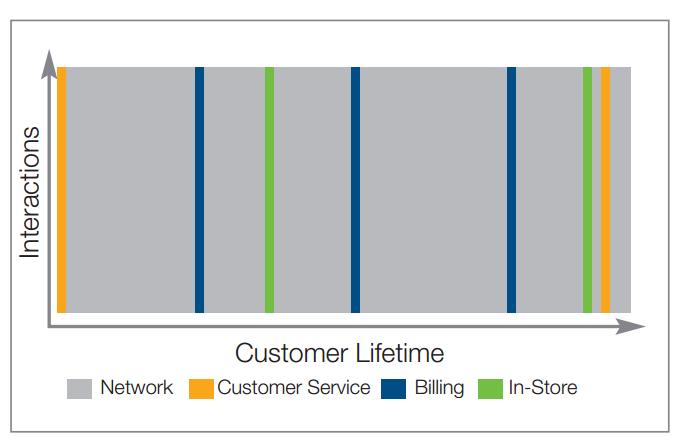To improve customer advocacy and loyalty, communications service providers (CSPs) are now looking to superior customer experience management as a key differentiator, writes René TononThere is no denying that customers now demand more than ever when it comes to the mobile experience. In this constantly evolving, multi-channel, multi-service world, in which mobile data consumption is insatiable, subscribers expect a consistent and reliable service across all devices, from all locations. And with at least two CSPs as a minimum in most countries, and as many as fifteen in places such as India and Canada, subscribers are spoilt for choice.
So what is it that affects the customer experience?
Customer experience can be defined as the entirety of all interaction a customer has with a company and/or its products. In the telecoms space, subscribers interact with a CSP via many touchpoints, whether this is initially purchasing a handset and contract, during the setup and provisioning phase of their service activation, during the day-to-day usage of services, or via any form of customer service correspondence.
We all want our provider to deliver value for money and the latest handsets. We want the device to be set up correctly and quickly, easy access to online and mobile billing, and speedy and helpful responses from customer care if and when we need to call. It is unquestionably important to measure the entire customer journey
Figure 1: The importance of network interaction
However, the average person will look at their phone a whopping 150 times a day according to a study by Nokia. Therefore the things that impact the user’s daily satisfaction the most are surely consistent and reliable access to, and the quality of, both voice and data services. The interaction with a device and the network is in actual fact the overriding important interaction between the customer and network operator, visually demonstrated in Figure 1. And in effect, the one that can have the highest impact on customer loyalty and churn. This was proven in the ‘2014 Mobile Loyalty Audit’ carried out by WDS, in which 4,000 users were asked what factors would make them switch network, with ‘better network coverage’ and ‘better data speeds’ coming out at the top with 48% and 43% respectively.
So to improve the customer experience and reduce customer churn, CSPs must pay the highest attention to the network itself; and be able to automatically correlate the quality of service with the customer experience, in order to prioritise efforts and investments.
CEM and network optimisation go hand-in-hand
CSPs already have access to vast amounts of data across the entire network: OSS, network probes and handset data to name a few. Historically network optimisation teams have simply worked to optimise the coverage to the highest number of people. Their performance has been measured based on statistics such as network reach, dropped call rates and cell handover. However they are going through a period of transition, and are beginning to correlate these traditional measures directly to CEM measures such as net promoter score(NPS), demonstrating the true impact of optimising the network. Of course there is no one-size fits all for customer experience; what is important to a pay-as-you-go customer may not be important to a contract, small office/home office(SOHO), SME or enterprise customer. It is critical that customer experience is looked at with the relevant segmentation in mind.
To successfully achieve this, CSPs are looking to tools, which allow them to correlate all of their data in one central application, and easily flag customer segments in real-time, enabling them to optimise the network to have the greatest impact on each customer type.
Upping the pace of customer experience management
Another critical factor in optimising the network performance, and in turn optimising the customer experience is speed. In the fast paced world we now live in, traditional methods for monitoring the network are no longer quick enough. For example, collecting network information using passive probes and archiving to a data warehouse for analysis hours or sometimes days later does not enable a CSP to rapidly identify and rectify performance degradation issues. CSPs must look to new measures to enable them to react quickly and with specific focus to action improvements related to customers, which will have a direct impact on their experience and drive loyalty. Social media is a prime example as one of the few channels that can provide CSPs with near real-time insights into the customer experience, whether it is a single Facebook post, or hundreds of thousands of tweets. It does however come with a challenge, in the fact that it is highly unstructured, and must be processed in real-time.
How can CSPs manage all this information without increasing headcount?
Most CSPs now have subscriber numbers in the millions, making it impossible to correlate network data and customer data manually. In today’s economy, a significant increase in headcount is unrealistic, therefore automation is key. To really make customer experience management a successful method for reducing customer churn, CSPs must begin to monitor trends and put automated actions into place. For example, if after five dropped calls, 95% of subscribers will contact customer care, CSPs can use this trend to introduce proactive automation techniques; When a customer reaches three dropped calls, an automatic alert can be sent to the customer care team, letting them know the customer is highly likely to get in touch, along with the reasoning for the dropped call rate. They can even go one step further and trigger an automatic SMS to the customer, apologising for the issue, and letting them know that it is being addressed.
It is clear to see that the network itself must play a key role in customer experience management, and CSPs must take a proactive approach in correlating their network and customer data. Automation is also key; enabling CSPs to optimise resources across the entire business whilst ensuring customer excellence is the top priority. This is even more important as some CSPs move towards quad play offerings, as a bad customer experience doesn’t just affect loss of mobile revenue but potentially all other services too.
And for those CSPs that are not already embracing CEM? Well they are already behind the competition and now risk being left behind completely.







